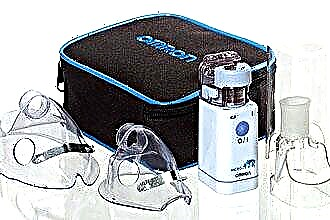Excessive discharge of clear fluid from the nose (rhinorrhea) is a companion of most respiratory diseases. If water flows from the nose when tilting, the reason for this is the hyperactivity of the glands (goblet cells) in the mucous membranes of the ENT organs. Neurovegetative disorders, infectious or allergic agents can provoke pathological processes.
The activity of the goblet cells in the nasopharynx is controlled by receptors. The effect of chemical and physical factors on the nerve endings leads to an increase or decrease in the secretory function of the unicellular glands. The article will consider the main reasons for the evacuation of mucus from the nose when the head is tilted, as well as the most effective methods of treating pathology.
Causes
 Nasal mucus (muconasal secretion) is a clear watery liquid that is produced by the glands of the nasopharyngeal mucosa, i.e. goblet cells. It contains mucoproteins, neutrophils, salt, water and epithelial cells. Mucus performs a protective function in the body - it removes foreign objects (dust, allergens) from the respiratory tract and prevents the development of pathogenic flora in the nasal cavity.
Nasal mucus (muconasal secretion) is a clear watery liquid that is produced by the glands of the nasopharyngeal mucosa, i.e. goblet cells. It contains mucoproteins, neutrophils, salt, water and epithelial cells. Mucus performs a protective function in the body - it removes foreign objects (dust, allergens) from the respiratory tract and prevents the development of pathogenic flora in the nasal cavity.
Rhinorrhea (hypersecretion of muconasal secretion) is a clear sign of inflammation of the upper respiratory tract. Undesirable reactions in tissues can be caused by:
Allergy
Allergy is a non-infectious disease, the cause of which is disruptions in the mechanisms of the implementation of immune responses to the action of allergens. In other words, allergy is an inadequate response of the immune system to the effects of irritating agents: dust, drugs, food, animal hair, etc. If, when the head is tilted, a clear liquid begins to drip from the nasal passages, most likely the reason for this is allergic rhinoconjunctivitis (hay fever).
In addition to rhinorrhea, hay fever is accompanied by the following symptoms:
- swelling of the nasopharyngeal mucosa;
- inflammation of the conjunctiva of the eyes;
- periodic lacrimation;
- Difficulty nasal breathing;
- constant sneezing.
Late treatment of allergic rhinoconjunctivitis is fraught with the development of sinusitis and purulent inflammation in the nasopharynx.
Few people know that mucus contains polysaccharides, which literally are food for pathogenic microbes and fungi. If you do not eliminate the hypersecretion and stagnation of mucus in the nose in time, subsequently this can provoke the multiplication of opportunistic microorganisms in the nasal cavity.
Viral diseases
If water starts dripping from the nose, catarrhal (non-purulent) inflammation in the respiratory tract may be the reason. Reproducing in mucous membranes, viruses provoke irritation of nerve endings in soft tissues. As a consequence, this leads to an increase in the secretory function of the goblet cells and the formation of an excess amount of clear liquid in the nose.
Hypersecretion of nasal secretions is most often associated with the development of the following respiratory diseases:
- sinusitis - inflammation of the maxillary (maxillary) paranasal sinuses, which is often preceded by colds;
- frontal sinusitis - unilateral or bilateral inflammation of the frontal paranasal sinuses, accompanied by pain in the brow region;
- ARVI is a group of respiratory diseases characterized by viral inflammation of the mucous membranes of the nasopharynx.
In 7 out of 10 cases, the release of nasal fluid when the trunk is tilted indicates the development of sinusitis.
Enhanced production of clear mucus often occurs at the initial stage of the development of viral infections. An increase in the amount of liquid exudate in the nasopharynx helps to flush out pathogenic agents from the respiratory tract. As the infectious process progresses, the consistency and color of the nasal secretion may change. The presence of an unpleasant putrid odor and yellow discharge may signal the formation of purulent foci of inflammation in the nasal cavity.
Vegetative disorders
Vasomotor rhinitis is a non-infectious disease characterized by thickening of the mucous membrane in the nasal cavity. Swelling of tissues is associated with a violation of the tone of blood vessels and their excess blood filling. Autonomic disorders can be provoked by:
- endocrine diseases;
- benign tumors (nasal polyps);
- curvature of the nasal septum;
- allergic reactions;
- abuse of vasoconstrictor drugs;
- vegetative dystonia.
Stressful situations, gassed air, hypotension and abuse of oral contraceptives increase the likelihood of developing vasomotor rhinitis by 3 times.
Water from the nose appears due to pathological changes in the structure of the tissues of the nasopharynx. Thickening of the mucous membranes leads to an increase in the number of goblet cells in the nasal cavity, which begin to produce even more muconasal secretions.
Principles of therapy
Methods for the treatment of rhinorrhea are determined by the reasons for the increase in the secretory activity of the unicellular glands in the nasopharynx. Viral diseases can be eliminated by taking drugs with antiviral and vasoconstrictor action, allergic rhinitis - with antihistamines, and autonomic disorders - with sympathomimetic drugs, which contribute to vasoconstriction in the nasal cavity.
Allergic rhinitis treatment
Allergic diseases are treated with antihistamines and hormonal anti-inflammatory drugs. Antiallergic medicines contain substances that interfere with the production of inflammatory mediators, which include serotonin and histamine. Typically, the treatment regimen for allergic rhinoconjunctivitis includes:
- topical glucocorticosteroids - "Acortin", "Beklat", "Prednisolone";
- antiallergic nasal agents - "Nazonex", "Allergodil", "Fenistil";
- antihistamine capsules and tablets - "Zirtek", "Rivtagil", "Diprazin".
During the flowering periods of wind-pollinated plants, people suffering from hay fever are advised to bury Nazaval into their nose.

Treatment of vasomotor rhinitis
Vasomotor rhinitis in most cases responds only to symptomatic treatment. In the absence of an effect from the use of medications, patients are prescribed physiotherapeutic procedures - phonophoresis with corticosteroids, laser therapy and electrophoresis with drugs based on calcium chloride.
 Of the drugs used to relieve the symptoms of vasomotor rhinitis:
Of the drugs used to relieve the symptoms of vasomotor rhinitis:
- sympathomimetic drugs - "Nazol", "Ephedrine", "Sanorin";
- alpha-blockers - "Xymelin", "Naphtizin", "Nazivin";
- antihistamines - Supramin, Bravegil, Clemastin;
With severe hypertrophy (thickening) of the nasopharyngeal mucosa, destruction of vascular structures in soft tissues is carried out, thereby reducing swelling in the nasal passages.
Respiratory Infection Treatment
It happens that when the head is tilted, the liquid pours out of the nose only for 3-4 days, after which the symptomatic picture is complemented by myalgia (muscle pain), weakness, fever, etc. As a rule, this indicates the development of a viral infection in the respiratory organs. To eliminate unpleasant symptoms and pathogenic flora in the foci of inflammation, use:
- antiviral tablets and capsules - Tamiflu, Amizon, Remantadin;
- vasoconstrictor nasal drops - Otrivin, Knoxprey, Galazolin;
- local antiviral ointments - Viferon, Pinosol, Oxolinic ointment;
- solutions for rinsing the nose - "Chlorhexidine", "Sodium Chloride", "Miramistin".
Important! Antiviral agents do not help in the treatment of bacterial and purulent inflammation of the nasopharynx.
Antiviral drugs help to destroy only viral pathogens - adenoviruses, coronaviruses, picornaviruses, etc. If the nasal secretion has a yellow color and an unpleasant pungent odor, in 93% of cases this indicates the development of bacterial or fungal flora in the respiratory organs.



